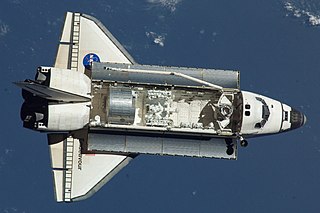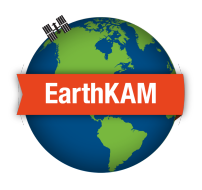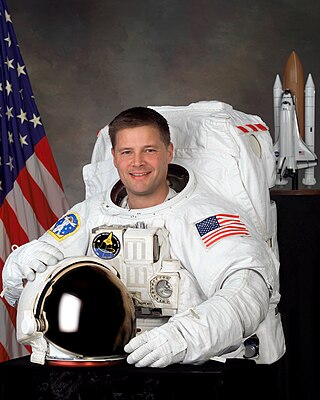
The International Space Station (ISS) is a large space station that was assembled and is maintained in low Earth orbit by a collaboration of five space agencies and their contractors: NASA, Roscosmos (Russia), ESA (Europe), JAXA (Japan), and CSA (Canada). The ISS is the largest space station ever built. Its primary purpose is to perform microgravity and space environment experiments.

Space Shuttle Atlantis is a retired Space Shuttle orbiter vehicle which belongs to NASA, the spaceflight and space exploration agency of the United States. Atlantis was manufactured by the Rockwell International company in Southern California and was delivered to the Kennedy Space Center in Eastern Florida in April 1985. Atlantis is also the fourth operational and the second-to-last Space Shuttle built. Its maiden flight was STS-51-J made from October 3 to 7, 1985.

Space Shuttle Endeavour is a retired orbiter from NASA's Space Shuttle program and the fifth and final operational Shuttle built. It embarked on its first mission, STS-49, in May 1992 and its 25th and final mission, STS-134, in May 2011. STS-134 was expected to be the final mission of the Space Shuttle program, but with the authorization of STS-135 by the United States Congress, Atlantis became the last shuttle to fly.

Richard Allen Garriott is a British-born American video game developer, entrepreneur and private astronaut.

Space Adventures, Inc. is an American space tourism company founded in 1998 by Eric C. Anderson. Its offerings include zero-gravity atmospheric flights, orbital spaceflights, and other spaceflight-related experiences including cosmonaut training, spacewalk training, and launch tours. Plans announced thus far include sub-orbital and lunar spaceflights, though these are not being actively pursued at present. Nine of its clients have participated in the orbital spaceflight program with Space Adventures, including one who took two separate trips to space.

Yury Valentinovich Lonchakov is a Russian former cosmonaut and a veteran of three space missions. He has spent 200 days in space and has conducted two spacewalks. From 2014 to 2017, Lonchakov served as head of the Yuri Gagarin Cosmonaut Training Center.

Owen Kay Garriott was an American electrical engineer and NASA astronaut, who spent 60 days aboard the Skylab space station in 1973 during the Skylab 3 mission, and 10 days aboard Spacelab-1 on a Space Shuttle mission in 1983.

Michael Landon Gernhardt is a NASA astronaut and manager of the Environmental Physiology Laboratory, and principal investigator of the Prebreathe Reduction Program (PRP) at the Lyndon B. Johnson Space Center.

Scott Edward Parazynski is an American physician and a former NASA astronaut. A veteran of five Space Shuttle flights and seven spacewalks, Parazynski's latest mission was STS-120 in October 2007 – highlighted by a dramatic, unplanned extra-vehicular activity (EVA) to repair a live solar array. In May 2016 he was inducted into the United States Astronaut Hall of Fame. He retired from NASA in March 2009 to pursue entrepreneurial opportunities in the private sector, and he is currently the CEO of a technology start-up. He is the first person to have both flown in space and summited Mount Everest, the highest point on Earth. He describes his life's experiences in his memoir The Sky Below.

Edward Michael "Mike" Fincke is an American astronaut who formerly held the American record for the most time in space. His record was broken by Scott Kelly on October 16, 2015.

The Destiny module, also known as the U.S. Lab, is the primary operating facility for U.S. research payloads aboard the International Space Station (ISS). It was berthed to the Unity module and activated over a period of five days in February, 2001. Destiny is NASA's first permanent operating orbital research station since Skylab was vacated in February 1974.

Sally Ride EarthKAM is a NASA educational outreach program started in 1996. The program was initiated by JoBea Way Holt, an Earth scientist from NASA's Jet Propulsion Laboratory, and was initially named KidSat. It allowed students to direct a digital camera aboard a series of space shuttle flights to take photographs of specific places on Earth. In 1998, KidSat was co-opted Dr. Sally Ride, the first American woman in space and renamed EarthKAM. Dr. Ride directed the installation of camera equipment on the International Space Station (ISS), where it became a permanent fixture independent of shuttle flights.

Douglas Harry "Wheels" Wheelock is an American engineer and astronaut. He has flown in space twice, logging 178 days on the Space Shuttle, International Space Station, and Russian Soyuz. On July 12, 2011, Wheelock announced that he would be returning to active duty with the United States Army in support of Operation Enduring Freedom. He is currently working with NASA to test the Orion spacecraft at the Glenn Research Center in Plum Brook, Ohio.

Soyuz TMA-12 was a Soyuz mission to the International Space Station (ISS) which was launched by a Soyuz FG rocket at 11:16 UTC on 8 April 2008. It docked to the Pirs module of the station on 10 April 2008. Landing occurred at 03:37 on 24 October. It was the first nominal landing in three missions, following separation failures on the Soyuz TMA-10 and 11 spacecraft.

Gregory Errol Chamitoff is a Canadian-born American engineer and former NASA astronaut. He has been to space twice, spending 6 months aboard the ISS across Expedition 17 and 18 in 2008, and another 15 days as part of STS-134 in 2011. STS-134 was the last of Space Shuttle Endeavour which delivered the Alpha Magnetic Spectrometer and completed the US Orbital Segment.

Sergey Aleksandrovich Volkov is a retired Russian cosmonaut and engineer. He was a member of three missions to the International Space Station, spending more than a year in total in space. During his missions he did four spacewalks lasting more than 23 hours in total. Volkov retired from the Cosmonaut group in February 2017.

Space art, also known as astronomical art, is a genre of art that visually depicts the universe through various artistic styles. It may also refer to artworks sent into space.

The National Aeronautics and Space Administration is an independent agency of the U.S. federal government responsible for the civil space program, aeronautics research, and space research. Established in 1958, it succeeded the National Advisory Committee for Aeronautics (NACA) to give the U.S. space development effort a distinct civilian orientation, emphasizing peaceful applications in space science. It has since led most of America's space exploration programs, including Project Mercury, Project Gemini, the 1968–1972 Apollo Moon landing missions, the Skylab space station, and the Space Shuttle. Currently, NASA supports the International Space Station (ISS) along with the Commercial Crew Program, and oversees the development of the Orion spacecraft and the Space Launch System for the lunar Artemis program.

The Mohammed Bin Rashid Space Center "MBRSC is a Dubai Government organisation, working on the UAE space program which includes various space satellites projects, such as the Emirates Mars Mission, the Emirates Lunar Mission, and the UAE astronaut program. The center actively works to promote space science and research in the region and encompasses the Emirates Institution for Advanced Science and Technology (EIAST).
The Center for the Advancement of Science in Space (CASIS), a non-profit organization, is the manager of the International Space Station United States National Laboratory, a US government-funded laboratory with principal research facilities located in the United States Orbital Segment of the International Space Station (ISS).





















